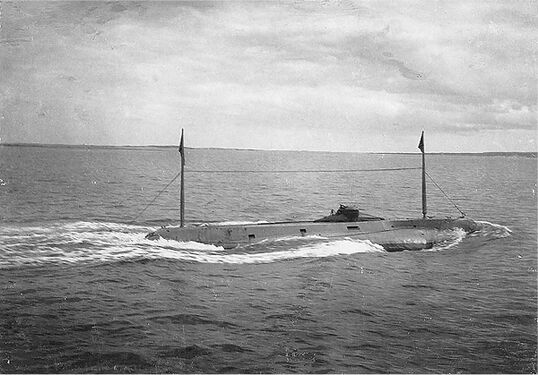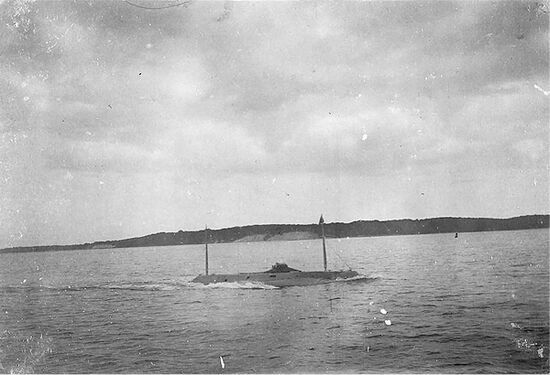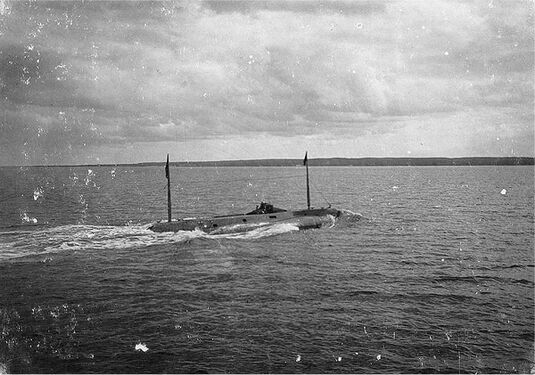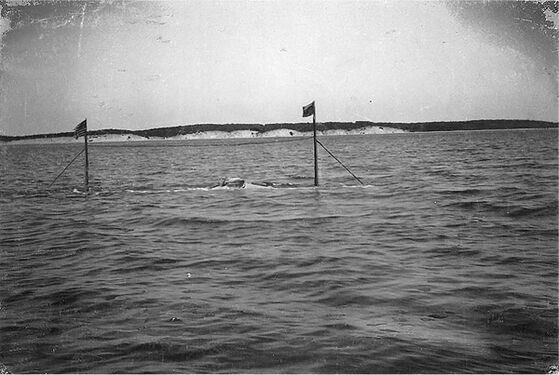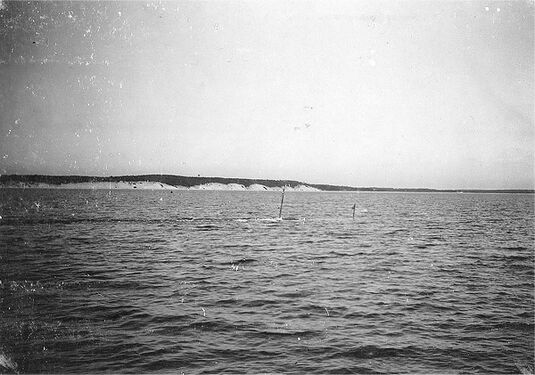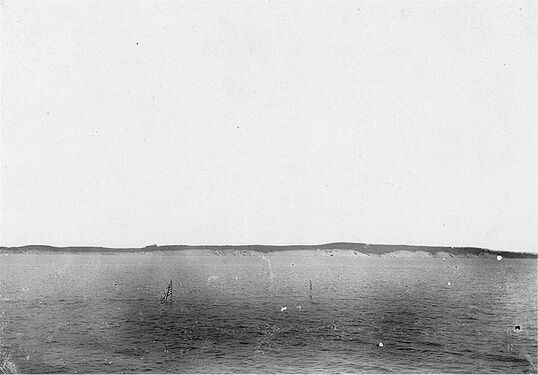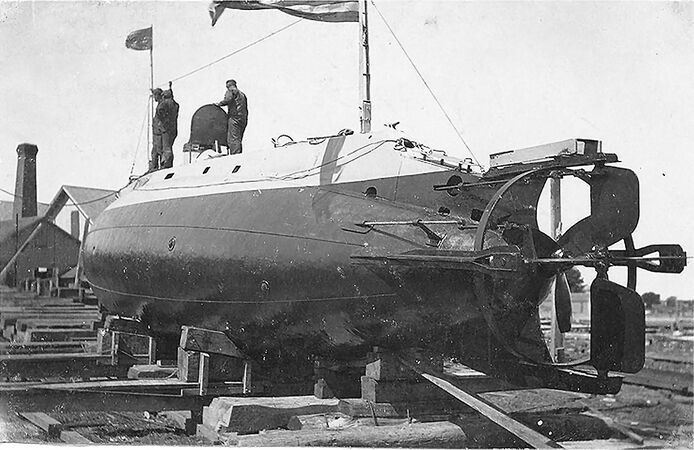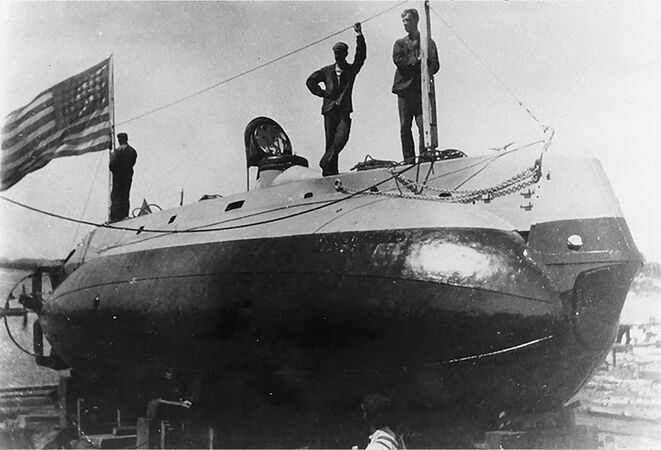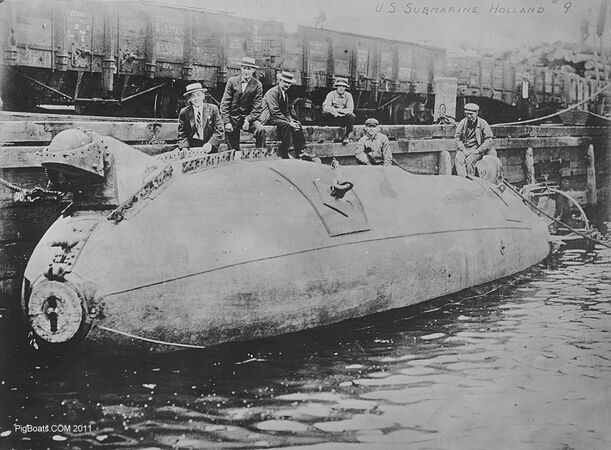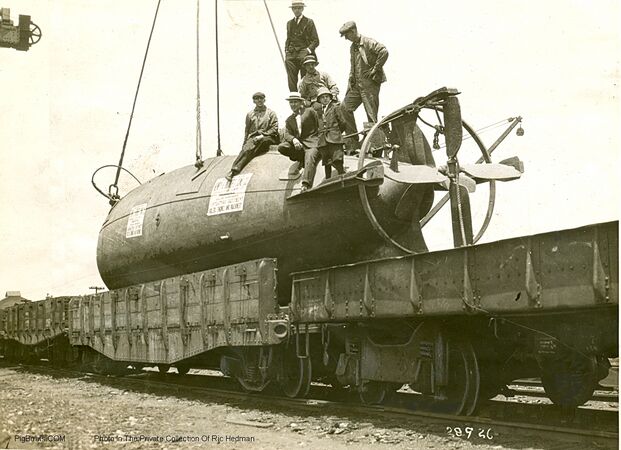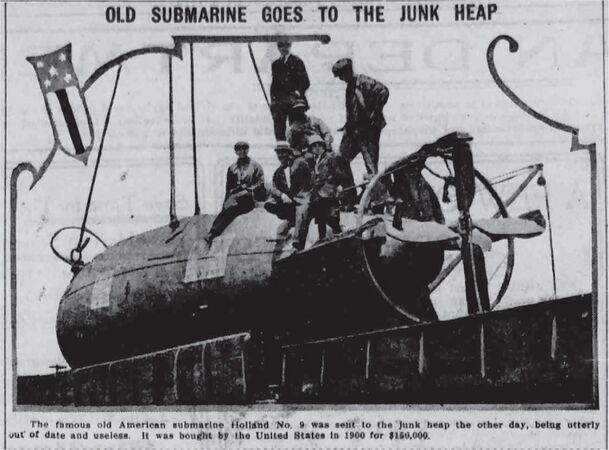Holland: Difference between revisions
Pbcjohnston (talk | contribs) mNo edit summary |
Pbcjohnston (talk | contribs) SEO updates |
||
| (90 intermediate revisions by 2 users not shown) | |||
| Line 1: | Line 1: | ||
[[ | {{#seo:|title=Submarine USS Holland - PigBoats.COM|title_mode=replace|keywords=USS Holland submarine 1900, USS Holland history, USS Holland photos, first US Navy submarine}} | ||
==Design and | {{#seo:|description=Notes, photographs, and pictures of the USS Holland submarine.}} | ||
Holland was built at Lewis Nixon's Crescent Shipyard in Elizabethport, NJ. | |||
[[File:New Header 1 Holland.jpg]] | |||
=== <big>Design, Construction, and Naming Notes</big> === | |||
<div style="text-align: justify;"><span style="color:#00008B">The submarine originally known as the Holland VI was built at Lewis Nixon's Crescent Shipyard in Elizabethport, NJ. between 1896 and 1897. Launched on May 17, 1897, three years of effort remained by her designer John Holland and his Holland Torpedo Boat Company before she would be accepted into the Navy. Commissioned on October 12, 1900 and named simply "Holland" she was the United States Navy's first official submarine. She served as a pathfinder for the next ten years, training a whole new type of sailor and developing tactics and strategy. Holland was a tremendously innovative step in submarine technology, pushing the state-of-the-art to its limits. She combined a fully workable system for underwater control with two separate systems for propulsion, one for surface cruising and one for submerged operation, thus dodging the three main devils that had plagued all submarine designs up to that point. Her successful design became the starting point for the USN Submarine Service, and Holland's legacy can still be seen today in modern nuclear submarines. The technological advances represented by Holland and the paradigm shift in naval tactics that she initiated kickstarted submarine development around the world, and in just a few years the navies of every significant nation on the earth would possess submarines as part of their fleet. | |||
Holland served the USN quite well as a technology and concept demonstrator. However, despite her leading-edge qualities, she was quickly eclipsed by the rapidly evolving submarine technology and was laid up and decommissioned on November 21, 1910. Her stripped out hulk lingered as a traveling exhibit for various private organizations until 1932, when she was unceremoniously scrapped. It is indeed sad that her historical value could not be recognized at the time. She would have made a fine exhibit at the Smithsonian. | |||
Because of her decommissioning date she was not affected by the Navy's change in naming convention for submarines that went into effect on November 17, 1911 and the change in designation systems that was put into place on July 17, 1920. As a result, Holland was known throughout her service life as Holland (Submarine No. 1). Even the common prefix of USS (United States Ship) was not officially adopted until 1909. She never officially carried the designation SS-1 at any point in her career, although many historians will retroactively apply it for continuity purposes. PigBoats.COM will adhere to the official Navy policy that was in effect during the boat's service career.</span> | |||
[[File:Red bar sub.jpg]] | |||
<div style="text-align: justify;"><span style="color:#000000"> | |||
=== <big>An overview of John Holland and the development of the first USN submarine</big> === | |||
</div> | |||
{{#ev:youtube|id=mVzhn3X93Hg|alignment=left|dimensions=500x300}} | |||
<div style="text-align: justify;"><span style="color:#00008B">This 1971 U.S. Navy film is a dramatic retelling of the story of John P. Holland and his paradigm changing submarine. It gets a little dramatic in some areas, but overall it is well done. The actor that was cast to play John Holland looks very much like the inventor, and portrays Holland's tendency towards irascibility well. They even built a convincing recreation of the boat for surface filming. Later in the film there are some good scenes of our early nuclear submarines as the film makers tied in the early developments to the "modern" submarine force. The script gets a little reflective and insightful at the end, and it makes you wonder what John Holland really would have thought of our mighty nuclear submarines of today. | |||
[[File:Red bar sub.jpg]] | |||
<div style="text-align: justify;"><span style="color:#000000"> | |||
=== <big>Construction, Launch, and Early Testing</big> === | |||
</div> | |||
[[File:Holland interior.jpg|left|500px]] | |||
<div style="text-align: justify;"><span style="color:#00008B">Interior of the Holland VI looking aft while under construction at Lewis Nixon's Crescent Shipyard in Elizabethport, New Jersey. This view is from roughly the center of the boat looking aft into the engineering spaces. The reduction gear can be seen, but the engine has not yet been installed. At the top is a large opening where hull plating is still to be installed. The hull frames are covered with a large canvas tarp. | |||
<small>U.S. Navy Photo</small> | |||
[[File:Red bar sub.jpg]] | |||
[[File:Holland-preping 1897.jpg|left|500px]] | |||
<div style="text-align: justify;"><span style="color:#00008B">Holland VI on the building ways at Crescent Shipyard just before her launch on May 17, 1897. On the right a ring-style shroud can be seen around her propeller. It was removed before she started sea trials. This also shows the original configuration of her propeller and rudder. The rudders quickly proved to be too small and were later enlarged, then later moved aft of the propeller. Above and just forward of the upper rudder is a small circular opening for her aft firing Zalinski pneumatic "dynamite" gun. Workmen are clearing the ways for launch and a large object is being lowered down the access hatch at top. | |||
<small>U.S. Navy Photo</small> | |||
[[File:Red bar sub.jpg]] | |||
[[File:Holland-christening 1897.jpg|left|500px]] | |||
<div style="text-align: justify;"><span style="color:#00008B">The christening of the submarine boat Holland by Mrs. Lewis Nixon, May 17, 1897 at her husband's Crescent Shipyard in Elizabethport, NJ. John Holland can be seen to the right of Mrs. Nixon in his bowler hat and wing collar. To the right in the group of workmen the man in the suit and hat with the wing collar looks to be Mr. Matthews, a Holland Torpedo Boat Company investor. | |||
<small>U.S. Navy Photo</small> | |||
[[File:Red bar sub.jpg]] | |||
[[File:Holland-launch 1897.jpg|left|500px]] | |||
<div style="text-align: justify;"><span style="color:#00008B">Holland on her launch day, May 17, 1897 at the Crescent Shipyard amid much fanfare, bells ringing, and ships whistles blowing as she slides into the Arthur Kill waters. She is still partially on the launch cradle. At this point the hull is just starting to become buoyant. She is flying a 45-star flag donated by Lewis Nixon. Oklahoma, Arizona and New Mexico had not been admitted to the Union yet and Alaska and Hawaii were still 60 years away from admission. Holland was still a work in progress at this point. Over three years of tests, trials, and modifications were still to come before the Navy would accept and commission her into service. | |||
<small>U.S. Navy Photo</small> | |||
[[File:Red bar sub.jpg]] | |||
[[File:hollad gun.jpg|left|500px]] | |||
<div style="text-align: justify;"><span style="color:#00008B">After making her first dive on St Patrick's Day, March 17, 1898, the Holland made a dive for a Navy Department observer, LT Nathan Sargent, on Sunday March 27, 1898 in Staten Island Sound and then returned to the Raritan docks. Here the Holland tested her forward Zalinski gun for the Navy. The boat was aimed at Tottenville on Staten Island (the Zalinski gun was fixed in place) and the gun charged with only 600 pounds of compressed air instead of the 1000 pounds Holland had wanted. Upon firing the three foot long, fifty pound wood dummy-projectile, (circled), sailed 300 yards across the channel. | |||
The gun was also fully capable of being fired with the boat just below the surface. The range would be considerably less due to water resistance, but the projectile would break the surface and continue in a ballistic arc. While there is no evidence to show that this was ever actually tested, this capability makes the Holland the first submarine capable of firing a ballistic missile while submerged. | |||
The Zalinski pneumatic gun was innovative but had very limited performance and thus its career with the U.S. military was short. For a good description of the gun and its variations, please see the information at [http://www.navweaps.com/Weapons/WNUS_Zalinsky.php '''this NavWeaps link'''], and at [https://en.wikipedia.org/wiki/Dynamite_gun '''this link''']. | |||
<small>U.S. Navy Photo</small> | |||
[[File:Red bar sub.jpg]] | |||
[[File:newspaper1898.jpg|left|500px]] | |||
<div style="text-align: justify;"><span style="color:#00008B">Shortly after her first trials in 1898 the Holland was being written about in several newspapers, giving particulars concerning to her operation. She is seen here moored to docks in Perth Amboy, NJ for the press to see. | |||
<small>Library of Congress</small> | |||
[[File:Red bar sub.jpg]] | |||
[[File:perth amboy-1.jpg|left|500px]] | |||
<div style="text-align: justify;"><span style="color:#00008B">The Holland dock side at Perth Amboy, New Jersey after her initial trials on March 17, 1898. As a result of those first trials wooden fairings were added fore and aft of the conning tower to help the water flow around it. These can be seen here. The muzzle door to the Zalinski gun is open. Photo circa late March 1898.</span></div> | |||
<small>U.S. Navy Photo</small> | |||
[[File:Red bar sub.jpg]] | |||
<div style="text-align: justify;"><span style="color:#000000"> | |||
===<big>The April 20, 1898 Trials</big>=== | |||
</div></span> | |||
[[File:April 20 1898.jpg|left|500px]] | |||
<div style="text-align: justify;"><span style="color:#00008B">Photo taken on April 20, 1898. Left to Right are: | |||
'''Walter Thompson''', superintendent of the Raritan Dry Dock. | |||
'''Charles A. Morris''', superintending engineer of the John P. Holland Torpedo Boat Company. | |||
'''John P. Holland''', inventor of the submarine. | |||
'''Mr. Matthews''', an investor in the John P. Holland Torpedo Boat Company | |||
All there to witness the first real trial run of the submarine boat Holland on Raritan Bay before a Navy Board of Inspection. | |||
<small>US Navy Photo</small> | |||
[[File:Red bar sub.jpg]] | |||
[[File:C a morris.jpg|left|500px]] | |||
<div style="text-align: justify;"><span style="color:#00008B">Charles A. Morris. A talented marine engineer and a personal friend of John Holland. His expertise was invaluable in getting the submarine completed and accepted by the Navy. | |||
<small>Morris Family Photo</small> | |||
[[File:Red bar sub.jpg]] | |||
[[File:Holland april-2.jpg|left|500px]] | |||
<div style="text-align: justify;"><span style="color:#00008B">The tug George P. Roe approaching the submarine boat Holland for the tow to the diving area for trials before the Navy Board. | |||
<small>U.S. Navy Photo</small> | |||
[[File:Red bar sub.jpg]] | |||
[[File:Holland april-1.jpg|left|500px]] | |||
<div style="text-align: justify;"><span style="color:#00008B">The Holland with crew bringing lines from the tug George P. Roe for her tow out into Raritan Bay. | |||
<small>U.S. Navy Photo</small> | |||
[[File:Red bar sub.jpg]] | |||
[[File:Holland april-0.jpg|left|500px]] | |||
<div style="text-align: justify;"><span style="color:#00008B">Officials and guests on the tug George P. Roe with the Holland alongside heading out into Raritan Bay between Staten Island and New Jersey for diving trials. The second man from the left looks to be Mr. Matthews, an investor in the John P. Holland Torpedo Boat Company. | |||
<small>U.S. Navy Photo</small> | |||
[[File:Red bar sub.jpg]] | |||
[[File:Holland april-3.jpg|left|500px]] | |||
<div style="text-align: justify;"><span style="color:#00008B">The Holland casts loose from the tug George P. Roe, just before her hour-long dive. | |||
<small>U.S. Navy Photo</small> | |||
[[File:Red bar sub.jpg]] | |||
[[File:Holland april-4.jpg|left|500px]] | |||
<div style="text-align: justify;"><span style="color:#00008B">Holland surfaces after her trial dive that lasted almost an hour in length and ran a looping course of several miles. It was also a longer dive than spelled out in the Navy requirements. The Navy was only mildly impressed but around the world other countries were taking notice and offers were made to buy the submarine. | |||
<small>U.S. Navy Photo</small> | |||
[[File:Red bar sub.jpg]] | |||
[[File:Holland april-5.jpg|left|500px]] | |||
<div style="text-align: justify;"><span style="color:#00008B">The Holland waiting to be picked up by her tow, tug George P. Roe, before heading back to Perth Amboy, NJ. Holland crew members are topside to handle lines. John Holland is the middle figure on the deck wearing his trademark bowler hat. | |||
<small>U.S. Navy Photo</small></div></span> | |||
[[File:Red bar sub.jpg]] | |||
<div style="text-align: justify;"><span style="color:#000000"> | |||
===<big>The Erie Basin Haulout</big>=== | |||
</div></span> | |||
[[File:erie basin dd-1.jpg|left|500px]] | |||
<div style="text-align: justify;"><span style="color:#00008B">After her successful trials for the Navy on April 20, 1898, Holland was towed to the Erie Basin in the south Brooklyn neighborhood of Red Hook. She arrived there on May 1, 1898. The Holland was hauled out at the Erie Basin yard of the J. N. Robins Company that operated at the foot of 50th Street. A new experimental propeller and modifications to her steering were made in this 24-hour period. | |||
<small>U.S. Navy Photo</small> | |||
[[File:Red bar sub.jpg]] | |||
[[File:erie basin dd-2.jpg|left|500px]] | |||
<div style="text-align: justify;"><span style="color:#00008B">This is a view from the port quarter and shows the enlarged rudders that were installed in an attempt to improve handling. Holland and his engineers simply added surface area onto the existing rudders, but even this proved to be insufficient with trials showing she still lacked the desired maneuverability.</span> | |||
<small>US Navy Photo</small> | |||
[[File:Red bar sub.jpg]] | |||
[[File:erie basin dd-3.jpg|left|500px]] | |||
<div style="text-align: justify;"><span style="color:#00008B">A view from dead astern with a view of the propeller. The prop seems to be of the same design, but they may have changed the pitch of the blades to get better performance.</span> | |||
<small>US Navy Photo</small> | |||
[[File:Red bar sub.jpg]] | |||
[[File:erie basin dd-4.jpg|left|500px]] | |||
<div style="text-align: justify;"><span style="color:#00008B">Holland from the starboard bow while in the Robins yard in Brooklyn. The muzzle door for the single torpedo tube is open, along with the muzzle door for the Zalinski gun at the upper tip of the bow. </div></span> | |||
<small>US Navy Photo</small></div></span> | |||
[[File:Red bar sub.jpg]] | |||
<div style="text-align: justify;"><span style="color:#000000"> | |||
===<big>The Atlantic Yacht Basin Haulout</big>=== | |||
</div></span> | |||
[[File:atlantic basin-1.jpg|left|500px]] | |||
<div style="text-align: justify;"><span style="color:#00008B"></div></span> | |||
In September 1898 the Holland was hauled out at the Atlantic Basin shipyard and extensive work was done. A new smaller propeller was installed, she received a fresh paint job, and the torpedo tube was re-bored. She was ready for further testing by November 4, 1898. On the 12th of November fresh trials began. This was the first time John Holland did not handle the submarine himself. | |||
<small>US Navy Photo</small></div></span> | |||
[[File:Red bar sub.jpg]] | |||
<div style="text-align: justify;"><span style="color:#000000"> | |||
===<big>Morris Heights Haulout</big>=== | |||
</div></span> | |||
[[File:morris heights-1.jpg|left|500px]] | |||
<div style="text-align: justify;"><span style="color:#00008B">After some disputes with the Navy over the handling of the submarine, Holland reluctantly agreed to redesign the rudder, diving planes and propeller locations. It was argued that placing the propeller forward of the planes would help the inexperienced crews handling of the sub easier, as it increased water flow over the control surfaces. The submarine was towed to the Gas Engine and Power Company yards at Morris Heights on the Harlem River for these modifications. In this photo the modifications have been completed. An anti-fouling ring has been placed around the propeller. The purpose of the rectangular box atop the rudder post is not known, but we speculate that it is related to the rudder operation. A ram rod for operating the rudder can be seen near the end of the superstructure skeg, and a ram rod for the diving planes is below that. Note also that the aft firing Zalinski gun was removed during this period. It was of dubious value and the Navy showed no interest in it at all. | |||
<small>US Navy Photo</small> | |||
[[File:Red bar sub.jpg]] | |||
[[File:morris heights-2.jpg|left|500px]] | |||
<div style="text-align: justify;"><span style="color:#00008B">A view of the stern modifications from a different angle. | |||
<small>US Navy Photo</small> | |||
[[File:Red bar sub.jpg]] | |||
[[File:nindermann.jpg|left|500px]] | |||
<div style="text-align: justify;"><span style="color:#00008B">Shown here working on the Holland overhaul is William F. C. Nindermann. He was a John P. Holland Torpedo Boat Company employee. He appears to be working on some interior piping for the submarine. The photo was taken at the Gas Engine and Power Company yard at Morris Heights on the Harlem River. A large awning has been erected over the boat's conning tower, probably to keep out anticipated rain.<br><br> | |||
<small>US Navy Photo</small></div> | |||
[[File:Red bar sub.jpg]] | |||
[[File:Holland plans 1899.jpg|left|500px]] | |||
Line drawings of the Holland as she appeared after the work was completed at the Morris Heights haulout. This was the configuration in which she would have her final demonstration to the Navy. | |||
<small>Image NH 77191 courtesy of NHHC.</small> | |||
[[File:Red bar sub.jpg]] | |||
<div style="text-align: justify;"><span style="color:#000000"> | |||
===<big>The New Suffolk Trials 1899</big>=== | |||
</div> | |||
[[File:Holland under tow for Gport trials.jpg|left|500px]] | |||
<div style="text-align: justify;"><span style="color:#00008B">The Holland, under tow by the lighter Columbia, is towed across Gardiners Bay, Long Island, New York, on her way to New Suffolk, Long Island for her summer 1899 trials before a new Naval Board of Inspection. The Holland was based at the leased Goldsmith and Tuthill Yard in New Suffolk, home to the relocated Holland Torpedo Boat Company offices. It would become the nation's first (unofficial) submarine base. | |||
<small>U.S. Navy photo</small> | |||
[[File:Red bar sub.jpg]] | |||
[[File:gp-trials-1.jpg|left|500px]] | |||
The Holland heading out on Little Peconic bay for trial runs. The course was laid out in a north-south direction parallel to Little Hog Neck and marked by flagged buoys. These photos were taken on an early July 1899 running of that course. | |||
<small>U.S. Navy photo</small> | |||
[[File:Red bar sub.jpg]] | |||
<center> | |||
<gallery mode="packed" widths="350px" heights="250px"> | |||
File:gp-trials-2.jpg | |||
File:gp-trials-3.jpg | |||
File:gp-trials-4.jpg | |||
</gallery> | |||
</center> | |||
<div style="text-align: justify;"><span style="color:#00008B">Three views of Holland beginning her surface trial run on Little Peconic Bay. Everyone has gone below, the hatch is shut, and the boat is rigged for dive. | |||
<small>U.S. Navy photo</small> | |||
[[File:Red bar sub.jpg]] | |||
<center> | |||
<gallery mode="packed" widths="350px" heights="250px"> | |||
File:gp-trials-5.jpg | |||
File:gp-trials-6.jpg | |||
File:gp-trials-7.jpg | |||
</gallery> | |||
</center> | |||
<div style="text-align: justify;"><span style="color:#00008B">The Holland making her dive on the measured course on Little Peconic Bay. For this run she remained at what would later be termed as "periscope depth". She did not go "deep", which for Holland was a mere 75 feet. As you can see the tips of her masts remained visible. | |||
<small>U.S. Navy photo</small> | |||
[[File:Red bar sub.jpg]] | |||
[[File:gp-trials-8.jpg|left|500px]] | |||
Holland heading back to New Suffolk, NY at the conclusion of the trial run in Little Peconic Bay, July 1899. | |||
<small>U.S. Navy photo</small> | |||
[[File:Red bar sub.jpg]] | |||
[[File:gp-trials-9.jpg|left|500px]] | |||
A view from the port quarter as Holland makes her way back to New Suffolk at the end of the trial run. | |||
<small>U.S. Navy photo</small> | |||
[[File:Red bar sub.jpg]] | |||
<div style="text-align: justify;"><span style="color:#000000"> | |||
===<big>The Greenport Haulout</big>=== | |||
</div> | |||
[[File:greenport haulout-1.jpg|left|500px]] | |||
<div style="text-align: justify;"><span style="color:#00008B">Following the 1899 trials, Holland was hauled out on a marine railway at Greenport, NY on Long Island for repairs and alterations suggested by the results of the trials. She is shown here at the beginning of that yard period, late summer of 1899. | |||
<small>U.S. Navy photo</small> | |||
[[File:Red bar sub.jpg]] | |||
[[File:greenport haulout-2.jpg|left|500px]] | |||
Holland hauled out at Greenport, NY., 1899. This view from the stern shows several Holland Company employees working at her stern. | |||
<small>U.S. Navy photo</small> | |||
[[File:Red bar sub.jpg]] | |||
<center> | |||
<gallery mode="packed" widths="400px" heights="300px"> | |||
File:greenport haulout-3.jpg | |||
File:greenport haulout-4.jpg | |||
</gallery> | |||
</center> | |||
<div style="text-align: justify;"><span style="color:#00008B">Two views of a freshly painted Holland on the marine railway at Greenport, NY, 1899. The work is completed and she is ready to go back into the water. | |||
<small>U.S. Navy photos</small> | |||
[[File:Red bar sub.jpg]] | |||
[[File:greenport haulout-5.jpg|left|500px]] | |||
Holland carefully being put back into the water on the marine railway at Greenport, NY, late summer 1899. Different from a traditional launching, the boat was carefully winched back into the water, with the cradle she was sitting on rolling on steel tracks laid on the slip. | |||
<small>U.S. Navy photo</small> | |||
[[File:Red bar sub.jpg]] | |||
<div style="text-align: justify;"><span style="color:#000000"> | |||
===<big>The Navy Days</big>=== | |||
</div> | |||
[[File:Holland and deck october 1900.jpg|left|500px]] | |||
<div style="text-align: justify;"><span style="color:#00008B">The USS Holland is seen here sometime shortly after her commissioning in the U.S. Navy on October 12, 1900. Her commissioning pennant is flying from her center or "main mast". She also has a temporary deck that John Holland so detested and heavily opposed, believing that they would affect performance. He felt they were only there "for officers to strut upon". The deck shown here was removable and would be left ashore before she headed out. The muzzle cap for her forward pneumatic gun is pointing to the camera. | |||
<small>U.S. Navy photo.</small> | |||
[[File:Red bar sub.jpg]] | |||
[[File:Holland and deck 2.jpg|left|500px]] | |||
Another view of Holland and her "strutting deck", most likely at the Holland company base at New Suffolk, Long Island. Several crew are on the pier. The second man from the left appears to be Chief of the Boat, Chief Gunner's Mate William H. Reader. The other man is unknown. Moored on the other side of the pier is a motor torpedo boat. On her stern, just below her name plaque is the former opening for her after pneumatic gun that was removed prior to acceptance by the Navy. A hand hold has been placed over the opening. | |||
<small>U.S. Navy photo.</small> | |||
[[File:Red bar sub.jpg]] | |||
[[File:Holland underway with launch.jpg|left|500px]] | |||
USS Holland underway, based on the background formation, on what seems to be Little Peconic Bay, Long Island, near New Suffolk, late 1900. Several men are topside and the head of the man steering is just seen sticking through the hatch. She is seen towing a skiff that is seen in some other photos. Her commissioning pennant is flying from her foremast and there seems to be a ventilator over the engine area to help air flow to the engine. The two "poles" seen attached to the masts are not booms but boat hooks to assist in coming along side docks and other vessels. | |||
<small>U.S. Navy photo.</small> | |||
[[File:Red bar sub.jpg]] | |||
[[File:Holland first crew.jpg|left|500px]] | |||
This is the crew of USS Holland, and the first U.S. Navy crew assigned to a submarine. These were brave men operating a futuristic machine on a new frontier. They were pathfinders in the truest sense of that word. | |||
In the center of the picture is Lieutenant Harry H. Caldwell, Commanding Officer (who bears a striking resemblance to actor Gabriel Byrne). Starting at the lower left of the picture and going clockwise are:<br><br> | |||
•William H. Reader, Chief Gunner's Mate <br> | |||
•Augustus Gumpert, Gunner's Mate <br> | |||
•Harry Wahab, Gunner's Mate 1st Class <br> | |||
•O. Swanson, Gunner's Mate 1st Class <br> | |||
•Owen Hill, Gunner (Warrant Officer) <br> | |||
•Walter A. Hall, Electrician's Mate 2nd Class <br> | |||
•Arthur Callahan, Gunner's Mate 2nd Class <br> | |||
•Barnett Bowie, Chief Machinist's Mate <br> | |||
<small>U.S. Navy photo.</small> | |||
[[File:Red bar sub.jpg]] | |||
[[File:Holland first cob.jpg|left|500px]] | |||
In the U.S. Navy Submarine Service, the Chief of the Boat (COB) is an experienced and wise Chief Petty Officer and the senior enlisted man aboard. He is the principal enlisted advisor to the commanding officer, and is the CO's "get it done man". Not only is he a subject matter expert on all things submarine, but he also keeps the enlisted men moving forward, sometimes with sharp and pointed words, sometimes with a grandfatherly pat on the back and wise insight. This photo highlights the force's very first COB, Chief Gunner's Mate William H. Reader, USN (center). Arrayed around him are the remainder of the Holland's first enlisted crew, the same men in the photo above. | |||
<small>U.S. Navy photo.</small> | |||
[[File:Red bar sub.jpg]] | |||
[[File:Holland-retzvian-a.jpg|left|500px]] | |||
The Holland entering dry dock at the Brooklyn Navy Yard in New York City, October, 1901. She is sharing the dry dock with the Russian battleship Retvizan. The Russian battleship was undergoing a refit prior to heading to join the Russian Pacific fleet at Port Arthur (present day Lushunkou, China). Retvizan had been built for the Imperial Russian Navy by the United States. Retvizan was torpedoed and heavily damaged prior to the famous Battle of Tsushima Straight in the Russo-Japanese War. But she was repaired in time to participate in the battle. She survived and was eventually taken over by the Japanese and renamed Hizen. She served Japan until being sunk as a gunnery target in 1924. | |||
<small>U.S. Navy photo.</small> | |||
[[File:Red bar sub.jpg]] | |||
[[File:Holland-retzvian-0.jpg|left|500px]] | |||
A high resolution closeup of Holland from the above photo. The bow is facing the camera. Her crew is all topside, working to ensure the lines are ready to steady the boat when the dock pumping begins. | |||
<small>U.S. Navy photo.</small> | |||
[[File:Red bar sub.jpg]] | |||
[[File:Holland retzvian b.jpg|left|500px]] | |||
Another view of Holland and Retvizan during the 1901 Brooklyn Navy Yard drydocking. In this photo the water is nearly drained and both ships are sitting firmly on the keel blocks at the bottom of the dock. LT Caldwell can be seen on Holland's deck, carefully monitoring the draining of the water. | |||
<small>U.S. Navy photo.</small> | |||
[[File:Red bar sub.jpg]] | |||
[[File:Holland retzvian C.jpg|left|500px]] | |||
This photo was taken several minutes after the one above, and shows the dock drained. An access gangplank has been placed to provide a means of getting to the Holland. Time would not be wasted and the men would get to work immediately. | |||
<small>U.S. Navy photo.</small> | |||
[[File:Red bar sub.jpg]] | |||
[[File:Holland drydock 1901-c.jpg|left|500px]] | |||
Another view of Holland during the 1901 drydocking. This shot gives a good view of her hull shape, a beautifully tapered cylinder. The Navy would quickly diverge from this hydrodynamically optimal shape, but would return to it in the 1960's and the Skipjack-class nuclear submarines with their "Albacore" style hulls. | |||
<small>U.S. Navy photo.</small> | |||
[[File:Red bar sub.jpg]] | |||
[[File:Holland 1901-a.jpg|left|500px]] | |||
The diminutive Holland moored at the Philadelphia Navy Yard in 1901. [https://www.navsource.org/archives/04/c12/c12.htm '''USS Columbia (Cruiser No. 12)'''] is partially visible in the background. The muzzle door for Holland's pneumatic gun is open. Theoretically, the gun was capable of launching it's dynamite shells while the boat was submerged, making the Holland the first submarine capable of launching a ballistic missile while submerged! While there is only anecdotal evidence to show that she actually did launch a projectile while submerged, she was certainly capable of doing so. | |||
<small>U.S. Navy photo.</small> | |||
[[File:Red bar sub.jpg]] | |||
[[File:Holland naval academy.jpg|left|500px]] | |||
At the U.S. Naval Academy, Annapolis, Maryland, circa 1901-1902, with several midshipmen on board. Among the midshipmen are, as identified from names on their uniforms:<br><br> | |||
•Naval Cadet Henry G.S. Wallace (entering conning tower)<br> | |||
•Naval Cadet John W. Woodruff (behind Wallace)<br> | |||
•Naval Cadet John. H. Blackburn (by the mast) and<br> | |||
•Naval Cadet William J. Moses (in front of the flag).<br><br> | |||
The careful method that Wallace is using to go down the hatch emphasizes the boat's small size and the fact that you did not enter the Holland, you ''put it on''. | |||
The officer standing by the conning tower is probably Holland's Commanding Officer, Lieutenant Harry H. Caldwell. Note Holland's bell mounted on her foremast, commissioning pennant flying from the top of her mainmast, outriggers fixed along her deck edge for decking that has been removed and the bow of the converted yacht [https://www.navsource.org/archives/12/09902.htm '''USS Gloucester'''] in the right background. | |||
<small>U.S. Navy photo.</small> | |||
[[File:Red bar sub.jpg]] | |||
[[File:Holland diving naval academy.jpg|left|500px]] | |||
Holland partially submerged in the Severn River off the U.S. Naval Academy, Annapolis, Maryland, in the summer of 1901. Maybe with cadets aboard as riders. Note the submarine's 13-star "boat" flag, signal mast fitted amidships and commissioning pennant. A large coastal monitor, possibly an Amphitrite-class vessel, is in the left background. | |||
<small>U.S. Navy photo.</small> | |||
[[File:Red bar sub.jpg]] | |||
[[File:Holland naval academy-2.jpg|left|500px]] | |||
Holland and her crew posing for a portrait while stationed at the Naval Academy circa 1903-1904. Two [http://www.navsource.org/archives/01/02bbidx.htm '''coastal defense monitors'''] are anchored in the background, a steam launch is moored alongside as a comparison for size. The left hand monitor is an Arkansas-class vessel, and the other is of the Amphitrite-class. | |||
<small>U.S. Navy photo.</small> | |||
[[File:Red bar sub.jpg]] | |||
[[File:Holland naval academy-3s.jpg|left|500px]] | |||
A closeup of the photo above, with callouts for the crew's names. By this time Gunner Owen Hill had taken over as Commanding Officer, a very rare occasion in which a warrant officer commanded a commissioned warship. | |||
<small>U.S. Navy photo.</small> | |||
[[File:Red bar sub.jpg]] | |||
[[File:Holland old crew1.jpg|left|500px]] | |||
Harry Wahab and Richard O. Williams, two of Holland's crewmen, seen here on April 11, 1947 at the Naval Academy at Annapolis. They stand by a model of the Holland, the Navy's first submarine, which had been accepted for service 47 years previously. | |||
<small>U.S. Navy photo.</small> | |||
[[File:Red bar sub.jpg]] | |||
[[File:Holland old crew2.jpg|left|500px]] | |||
Wahab and Williams in the company of a distinguished guest, Fleet Admiral Chester W. Nimitz at the Naval Academy, April 11, 1947. At the time of the photo Nimitz was the Chief of Naval Operations at the Pentagon. Nimitz was also a submariner, and commanded one of the Holland's follow-on boats, the USS [[A-1|'''Plunger (Submarine No. 2)''']] in 1909. | |||
<small>U.S. Navy photo.</small> | |||
[[File:Red bar sub.jpg]] | |||
<div style="text-align: justify;"><span style="color:#000000"> | |||
=== <big>The Twilight of a Career</big> === | |||
</div> | |||
[[File:Holland and Moccasin at Norfolk Navy yard 1908.jpg|left|500px]] | |||
<div style="text-align: justify;"><span style="color:#00008B">This photo shows an interesting scene at the Norfolk Navy Yard in Portsmouth, Virginia in 1908. This photo was taken from a boat in the southern branch of the Elizabeth River, looking west into the yard. It shows a section of the yard near the intersection of Brown Avenue (now Stevens St.) and Breese Avenue. On the right, two small submarines can be seen hauled out on berthing cradles. On the far right is the ex-Holland, and directly next to her is the USS Moccasin (Submarine No. 5). Moccasin is being held in reserve status, and would soon be refurbished and returned to service. Holland was decommissioned on July 17, 1905 and was being retained as a possible mobilization asset, but would not see further service. Technology had quickly left her behind, despite her pioneering nature. | |||
<small>Photo courtesy of NARA.</small> | |||
[[File:Red bar sub.jpg]] | |||
[[File:Holland at norfolk1.jpg|left|500px]] | |||
The ex-USS Holland hauled out at the Norfolk Navy Yard, Portsmouth, VA. The Holland had been struck from the Navy List on November 21, 1910, but her hulk lingered at the yard for several years. The men in the photo are in dress whites making this photo taken after Memorial Day, probably in 1911 since there isn't much taken from the Holland, just a few panels. The fairing in the bow and the fairing that surrounded the conning tower is gone as well. | |||
The ship on the right in the photo is a Delaware-class battleship, either the Delaware (BB-28) or the North Dakota (BB-29). The ship in the background is a Virginia-class battleship, either the Georgia (BB-15) or the New Jersey (BB-16). The crew on the dock could be from any ship in the area. | |||
Thanks to Charles Haberlein for identification. | |||
<small>Photo in the private collection of Ric Hedman.</small> | |||
[[File:Red bar sub.jpg]] | |||
<center> | |||
<gallery mode="packed" widths="400px" heights="300px"> | |||
File:Holland 03-15-1915-a-1.jpg|<small>Photo in the private collection of Ric Hedman.</small> | |||
File:Holland 03-15-1915-b.jpg|<small>New-York Tribune/Library of Congress image.</small> | |||
</gallery> | |||
</center> | |||
<div style="text-align: justify;"><span style="color:#00008B">The stripped out hulk of the former USS Holland sits high in the water. The superstructure has been removed along with the small conning tower. Decommissioned on November 21, 1910 she was sold for scrap on June 18, 1913. On board, from left to right, it is believed the men are Richard O. Williams, Harry Wahab and Charles A. Morris, John Holland's Supervising Engineer for the construction of the Holland. The other men are believed to be workmen. Interesting to note that by 1915 the Holland was thought to have been Holland's 9th submarine not the 6th. The ball-like object on the bow is the muzzle door for the Zalinsky pneumatic gun. On the right is a newspaper story using the same photo. The caption contains errors in describing the submarine like the muzzle of the Zalinsky gun being called the torpedo tube. The single torpedo tube can be seen on the end of the bow capped off by a plate. The tube and outer door having been removed when the submarine was decommissioned. The caption also talks about other subs not seen in the clipping. The train on the dock behind had been blanked out. | |||
[[File:Red bar sub.jpg]] | |||
[[File:Holland 06-24-1915.jpg|left|300px]] | |||
Stripped out hulk of the ex-Holland awaiting the end. The remnants of the after Zalinsky gun housing can be seen. The gun was removed before final Navy acceptance trials. | |||
<small>Evening Public Ledger.(Philadelphia)/Library of Congress image.</small> | |||
[[File:Red bar sub.jpg]] | |||
[[File:Holland liftout.jpg|left|500px]] | |||
ex-Holland being lifted to a rail car for transport, June 1915. The attached signs are apparently for the scrap company that now owned her. | |||
<small>Image Contributed by Gary McCue.</small> | |||
[[File:Red bar sub.jpg]] | |||
[[File:Holland workmen railcar.jpg|left|500px]] | |||
ex-Holland now on the blocks for transport by rail car, June 1915. Workmen are inspecting the positioning of the boat to ensure it is properly placed for transport. | |||
<small>Image Contributed by Gary McCue.</small> | |||
[[File:Red bar sub.jpg]] | |||
<center> | |||
<gallery mode="packed" widths="400px" heights="300px"> | |||
File:Holland c06-1915 original-1.jpg|<small>Photo in the private collection of Ric Hedman.</small> | |||
File:Holland c06-1915.jpg|<small>Iron County Record (Cedar City, Utah)/Library of Congress image.</small> | |||
</gallery> | |||
</center> | |||
<div style="text-align: justify;"><span style="color:#00008B">In these photos the ex-Holland has been placed on the railcar and is pausing for a photo op. The man in the center is Harry Wahab, former Holland crewman. The newspaper clipping from the Iron County Record shows the same scene. | |||
[[File:Red bar sub.jpg]] | |||
[[File:Holland at Commercial Museum-1.jpg|left|500px]] | |||
This photo shows the ex-Holland on display outside of the Commercial Museum in Philadelphia, approximately 1915. Her hulk is owned by the Henry A. Hitner & Sons Company, a scrap firm. Realizing the commercial value of the old boat, they put it on display trying to earn some money off of it. | |||
There is a platform built at the front of the submarine so visitors can look inside the sub through the torpedo tube opening. The tube and outer door had been removed by the Navy at decommissioning. | |||
This photo is distorting the actual shape of the boat, making it appear to be longer and thinner than it actually was. It is probably an artifact of the photography process. | |||
<small>Image Contributed by Gary McCue.</small> | |||
[[File:Red bar sub.jpg]] | |||
[[File:Holland VI in Philadelphia-1.jpg|left|500px]] | |||
The ex-Holland in Philadelphia at what is today the University of Pennsylvania Museum across the street from Franklin Field. The submarine is sitting on what will become part of museum building. It appears from this photo that South Street was at one time closer to the museum building than it is today. | |||
Compare images above with this one and you will see iron "straps" riveted to the hull fore and aft where the hull has been cut apart for transportation and then rejoined. In all the images to follow you will see these straps. | |||
<small>Image Contributed by Gary McCue.</small> | |||
[[File:Red bar sub.jpg]] | |||
[[File:Holland 10-17-1916.jpg|left|500px]] | |||
In August of 1916 she was privately purchased from Hitner by a Dr. Peter J. Gibbons and his son for $350.00 to be used for display and possibly placed in a museum. Here in this October 17, 1916 photo and newspaper story, "OLD SUBMARINE PROVES A HARMLESS TOY FOR SCHOOL CHILDREN" ''"Children of the McCall School paid a visit to the submarine Holland (SS-01), the first sub-sea craft in the United States Navy. The Holland is reposing, like a stranded amphibian, in the empty lots opposite Franklin Field before it goes to the Irish bazaar, in New York."'' | |||
<small>Evening Public Ledger.(Philadelphia)/Library of Congress image.</small> | |||
[[File:Red bar sub.jpg]] | |||
[[File:Holland 1916 Columbus Day-1a.jpg|left|500px]] | |||
The ex-Holland is being prepared for transport to be in the Columbus Day Parade in Philadelphia, so the date has to be just prior to October 12, 1916. | |||
The two cuts made in the hull to transport it to this location are clearly seen. The straps that riveted the hull sections back together are also clearly visible. The submarine appears to have been cut to move her from the Philadelphia Commercial Museum to the University of Pennsylvania Museum. Workmen are placing roller logs under the cradle and a large block and tackle have been rigged to the hull. | |||
<small>Photo in the private collection of Ric Hedman.</small> | |||
[[File:Red bar sub.jpg]] | |||
[[File:Holland 1916 Columbus Day-A.jpg|left|500px]] | |||
A photo from the Boston Courier newspaper taken some time shortly after the photo above was taken shows the logs in place and the slack taken up in the block and tackle ready to move the submarine. Part of the University of Pennsylvania Museum can be seen in the background. | |||
<small>Photo from the Buffalo Courier, October 29, 1916.</small> | |||
[[File:Red bar sub.jpg]] | |||
[[File:Holland bronx expo-1.jpg|left|500px]] | |||
May 25, 1917 the ex-Holland is lifted from a barge on its way to the Bronx International Exposition. The bridge in the background is the Willis Avenue Bridge from Manhattan to the Bronx and is still there looking almost the same. The Bronx is to the right in this photo. The pier is located at 125th Street and the Harlem River. The group in uniform is a contingent of the Junior Naval Reserve and is there as an honor guard. | |||
The sign reads: ''"Old Holland #9; Daddy Of All Submarines; (unreadable words); Bronx International Exposition Grounds; 177st Subway Station & Bronx River"''. Again, the misunderstanding about what build number the ex-Holland was. The ex-Holland was hull #6 not #9 in John Holland's design scheme and was the one the Navy bought. The Holland was to remain at this spot, as a derelict hulk until 1932 when she was purchased by the Harlem Metal Corporation for $100 and cut up for scrap. It was a sad end for such a historic vessel, and a complete shame that she was not preserved as a museum. | |||
<small>Photo in the private collection of Ric Hedman.</small> | |||
[[File:Red bar sub.jpg]] | |||
<center>[[Submarine Classes|Return to the Submarine Classes page]]</center> | |||
[[File:Red bar sub new.jpg]] | |||
<center> | |||
Page created by:<br> | |||
<span style="color:#00008B"> | |||
<small>Ric Hedman & David Johnston<br> | |||
1999 - 2023 - PigBoats.COM<sup>©</sup><br> | |||
Mountlake Terrace, WA, Norfolk, VA<br> | |||
webmaster at pigboats dot com</small> | |||
</center> | |||
[[File:Subs bottom line 2.jpg]] | |||
Latest revision as of 15:04, 8 May 2025
Design, Construction, and Naming Notes
Holland served the USN quite well as a technology and concept demonstrator. However, despite her leading-edge qualities, she was quickly eclipsed by the rapidly evolving submarine technology and was laid up and decommissioned on November 21, 1910. Her stripped out hulk lingered as a traveling exhibit for various private organizations until 1932, when she was unceremoniously scrapped. It is indeed sad that her historical value could not be recognized at the time. She would have made a fine exhibit at the Smithsonian.
Because of her decommissioning date she was not affected by the Navy's change in naming convention for submarines that went into effect on November 17, 1911 and the change in designation systems that was put into place on July 17, 1920. As a result, Holland was known throughout her service life as Holland (Submarine No. 1). Even the common prefix of USS (United States Ship) was not officially adopted until 1909. She never officially carried the designation SS-1 at any point in her career, although many historians will retroactively apply it for continuity purposes. PigBoats.COM will adhere to the official Navy policy that was in effect during the boat's service career.
An overview of John Holland and the development of the first USN submarine
Construction, Launch, and Early Testing
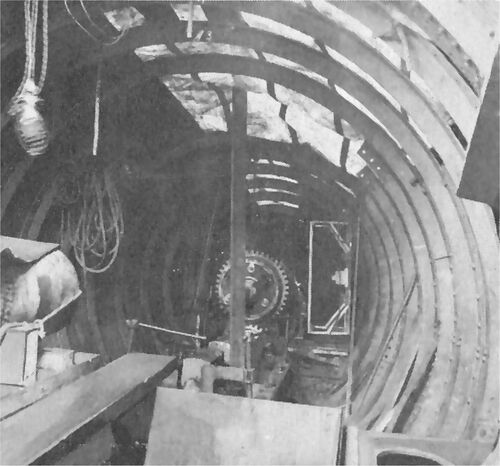
U.S. Navy Photo
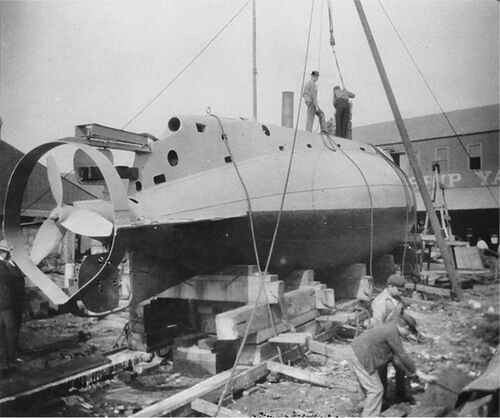
U.S. Navy Photo

U.S. Navy Photo
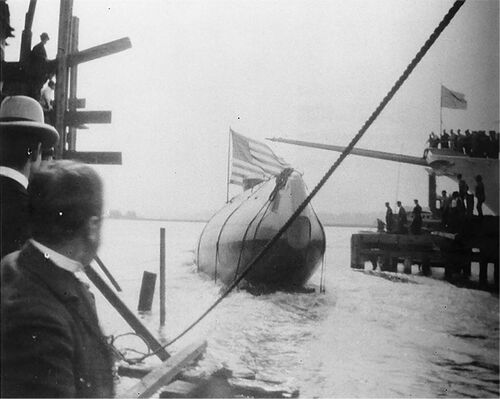
U.S. Navy Photo
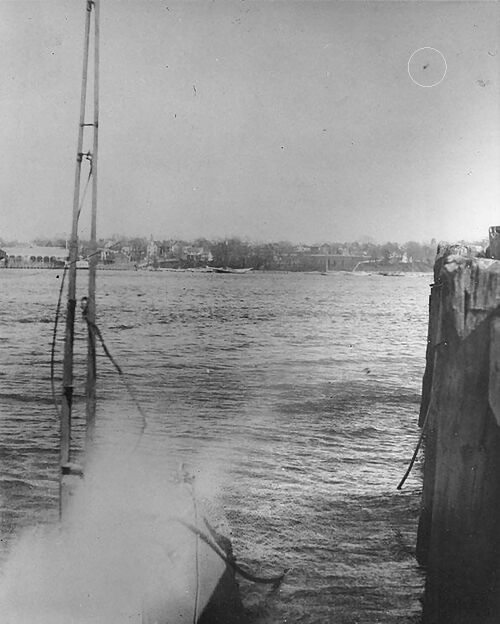
The gun was also fully capable of being fired with the boat just below the surface. The range would be considerably less due to water resistance, but the projectile would break the surface and continue in a ballistic arc. While there is no evidence to show that this was ever actually tested, this capability makes the Holland the first submarine capable of firing a ballistic missile while submerged.
The Zalinski pneumatic gun was innovative but had very limited performance and thus its career with the U.S. military was short. For a good description of the gun and its variations, please see the information at this NavWeaps link, and at this link.
U.S. Navy Photo
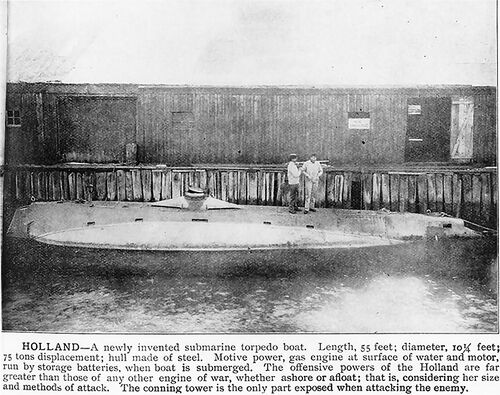
Library of Congress
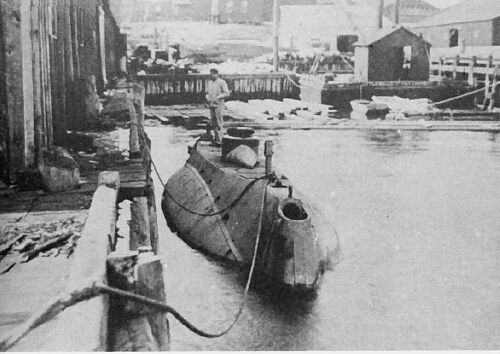
U.S. Navy Photo
The April 20, 1898 Trials
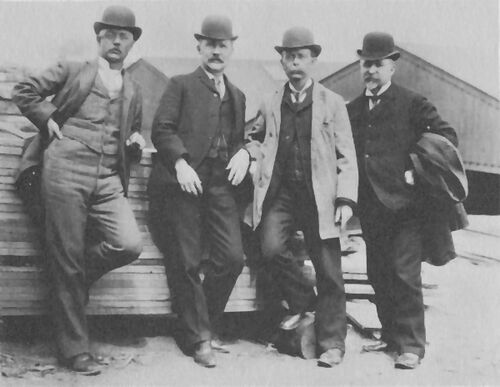
Walter Thompson, superintendent of the Raritan Dry Dock.
Charles A. Morris, superintending engineer of the John P. Holland Torpedo Boat Company.
John P. Holland, inventor of the submarine.
Mr. Matthews, an investor in the John P. Holland Torpedo Boat Company
All there to witness the first real trial run of the submarine boat Holland on Raritan Bay before a Navy Board of Inspection.
US Navy Photo
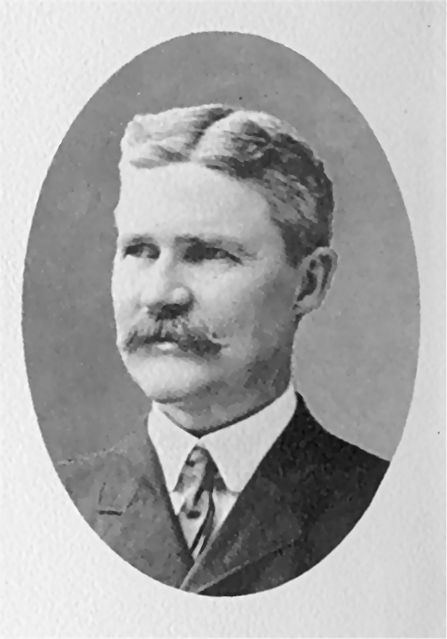
Morris Family Photo
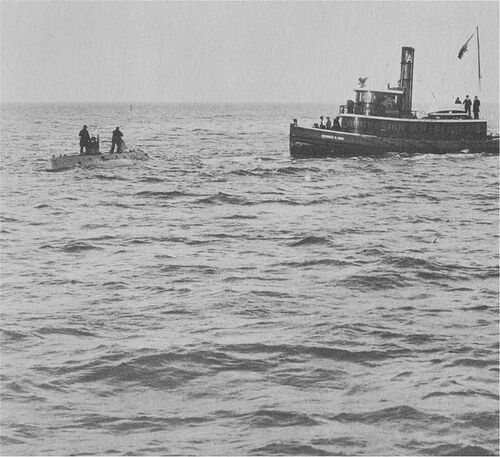
U.S. Navy Photo
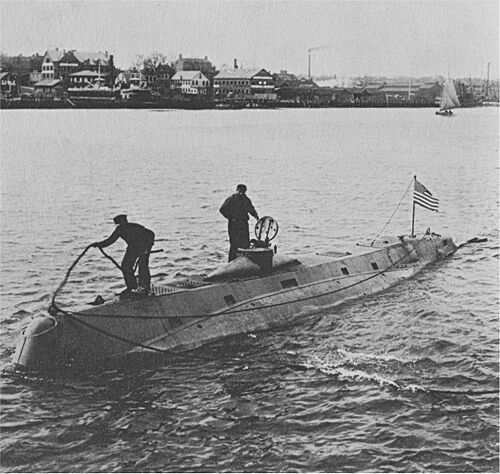
U.S. Navy Photo
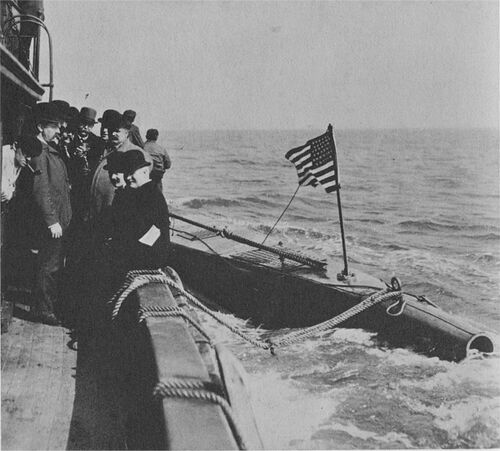
U.S. Navy Photo
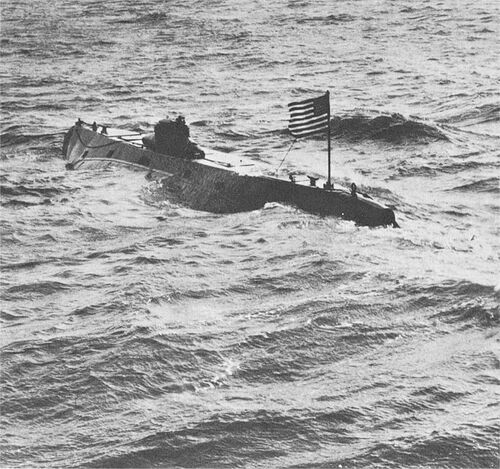
U.S. Navy Photo
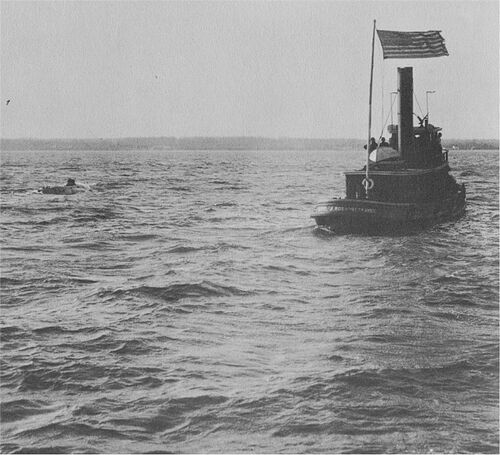
U.S. Navy Photo
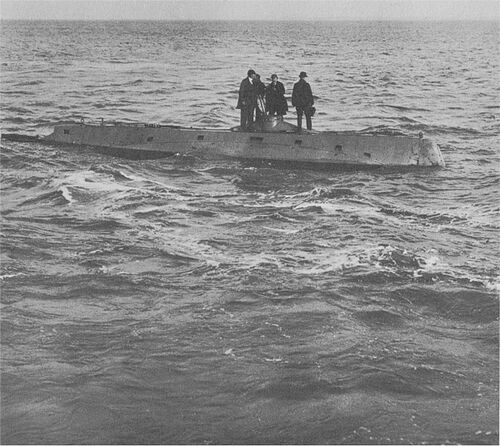
The Erie Basin Haulout
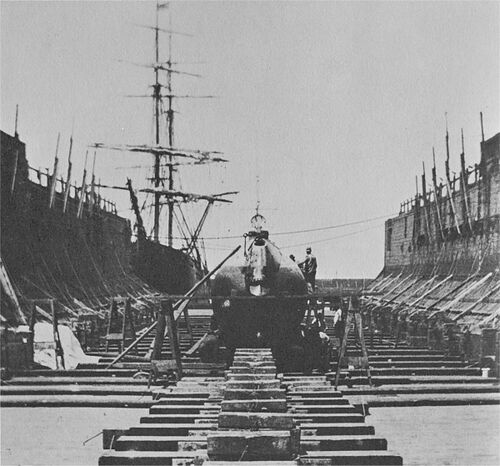
U.S. Navy Photo
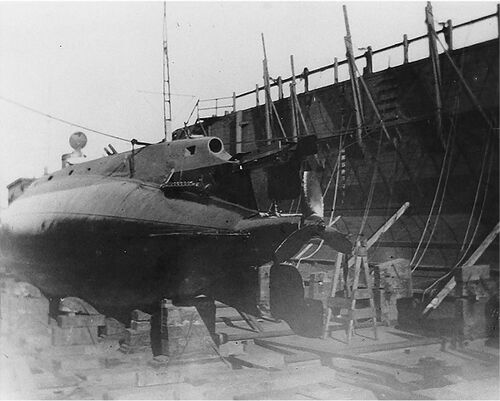
US Navy Photo
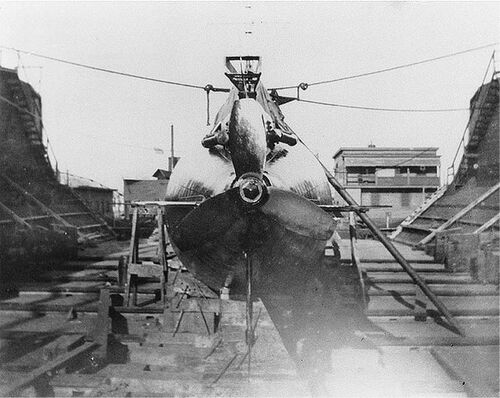
US Navy Photo
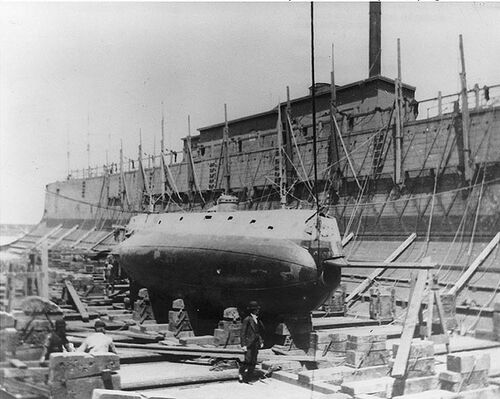
The Atlantic Yacht Basin Haulout
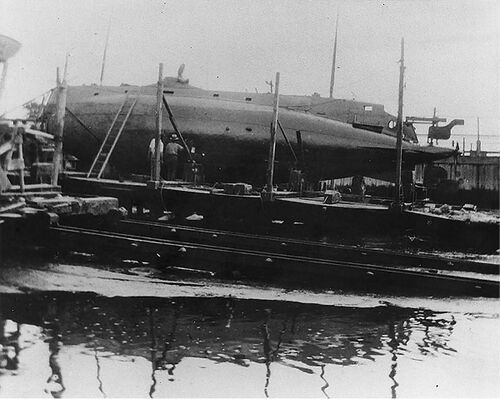
In September 1898 the Holland was hauled out at the Atlantic Basin shipyard and extensive work was done. A new smaller propeller was installed, she received a fresh paint job, and the torpedo tube was re-bored. She was ready for further testing by November 4, 1898. On the 12th of November fresh trials began. This was the first time John Holland did not handle the submarine himself.
US Navy PhotoMorris Heights Haulout
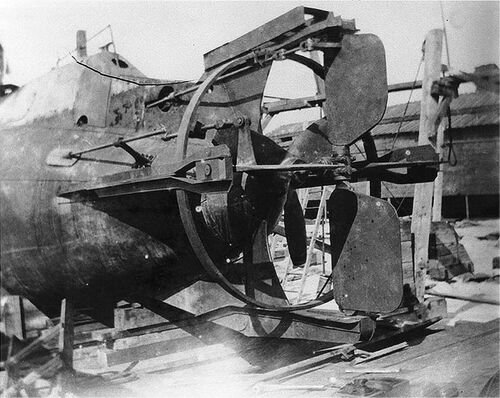
US Navy Photo
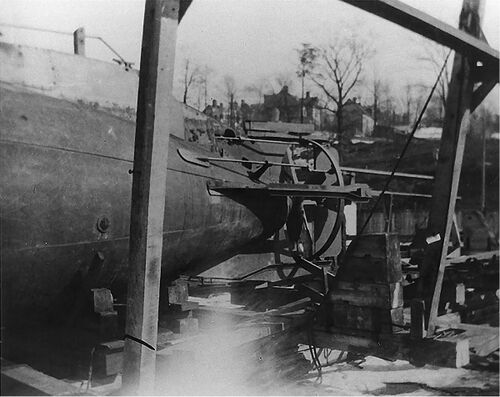
US Navy Photo

US Navy Photo
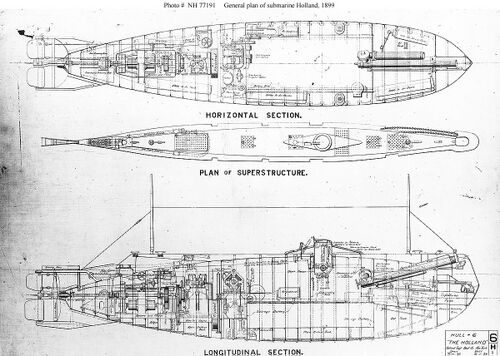
Line drawings of the Holland as she appeared after the work was completed at the Morris Heights haulout. This was the configuration in which she would have her final demonstration to the Navy.
Image NH 77191 courtesy of NHHC.
The New Suffolk Trials 1899

U.S. Navy photo
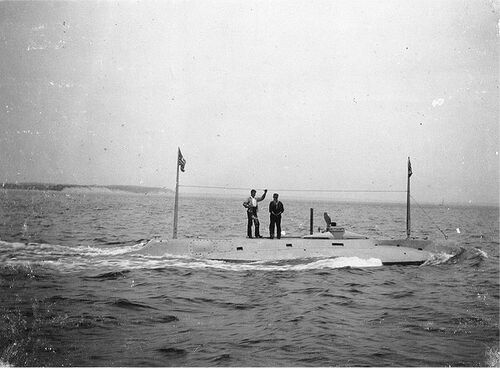
The Holland heading out on Little Peconic bay for trial runs. The course was laid out in a north-south direction parallel to Little Hog Neck and marked by flagged buoys. These photos were taken on an early July 1899 running of that course.
U.S. Navy photo
U.S. Navy photo
U.S. Navy photo

Holland heading back to New Suffolk, NY at the conclusion of the trial run in Little Peconic Bay, July 1899.
U.S. Navy photo
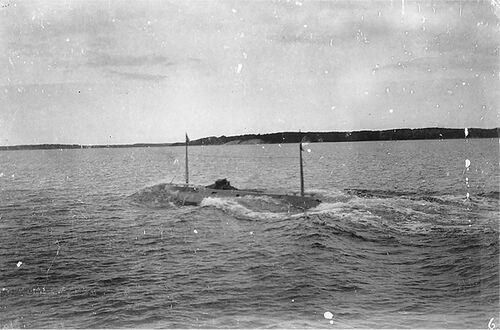
A view from the port quarter as Holland makes her way back to New Suffolk at the end of the trial run.
U.S. Navy photo
The Greenport Haulout
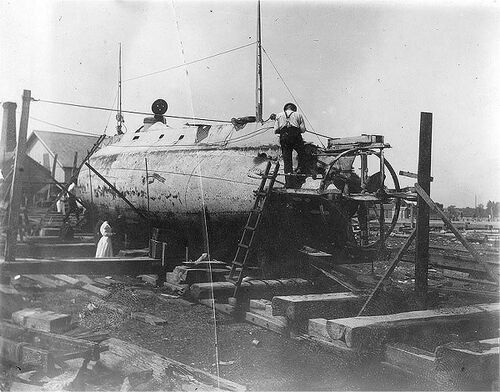
U.S. Navy photo
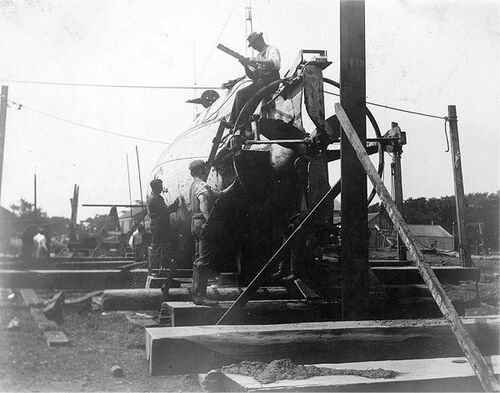
Holland hauled out at Greenport, NY., 1899. This view from the stern shows several Holland Company employees working at her stern.
U.S. Navy photo
U.S. Navy photos
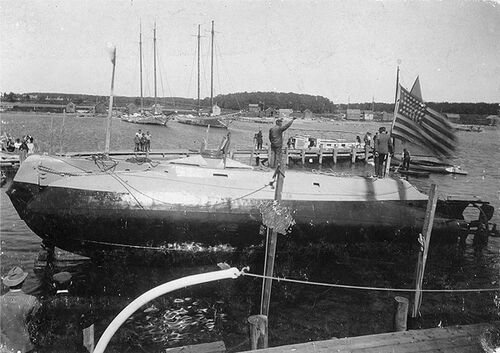
Holland carefully being put back into the water on the marine railway at Greenport, NY, late summer 1899. Different from a traditional launching, the boat was carefully winched back into the water, with the cradle she was sitting on rolling on steel tracks laid on the slip.
U.S. Navy photo
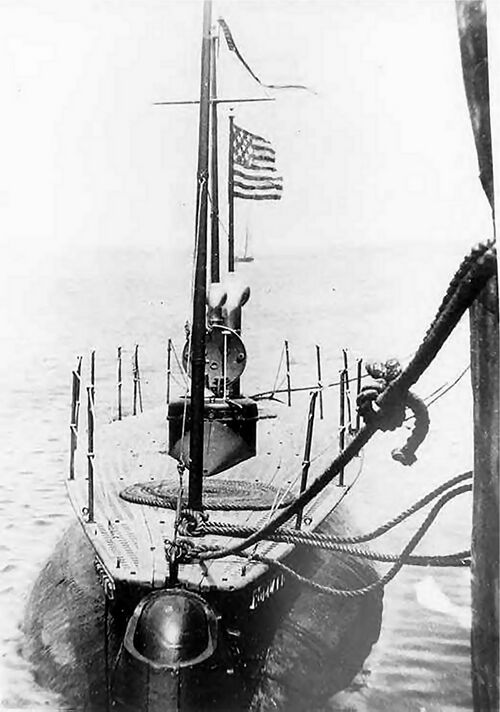
U.S. Navy photo.
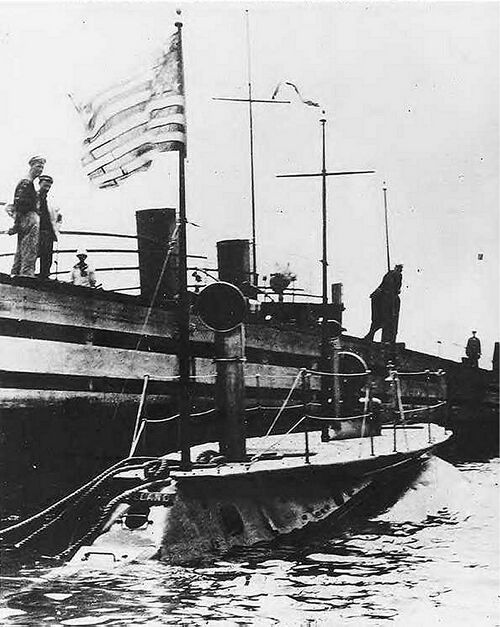
Another view of Holland and her "strutting deck", most likely at the Holland company base at New Suffolk, Long Island. Several crew are on the pier. The second man from the left appears to be Chief of the Boat, Chief Gunner's Mate William H. Reader. The other man is unknown. Moored on the other side of the pier is a motor torpedo boat. On her stern, just below her name plaque is the former opening for her after pneumatic gun that was removed prior to acceptance by the Navy. A hand hold has been placed over the opening.
U.S. Navy photo.
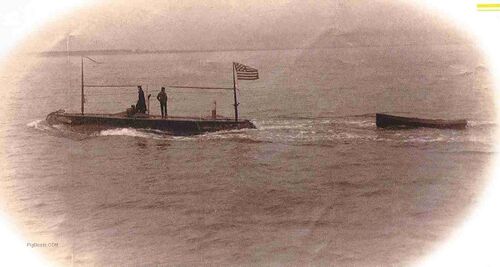
USS Holland underway, based on the background formation, on what seems to be Little Peconic Bay, Long Island, near New Suffolk, late 1900. Several men are topside and the head of the man steering is just seen sticking through the hatch. She is seen towing a skiff that is seen in some other photos. Her commissioning pennant is flying from her foremast and there seems to be a ventilator over the engine area to help air flow to the engine. The two "poles" seen attached to the masts are not booms but boat hooks to assist in coming along side docks and other vessels.
U.S. Navy photo.
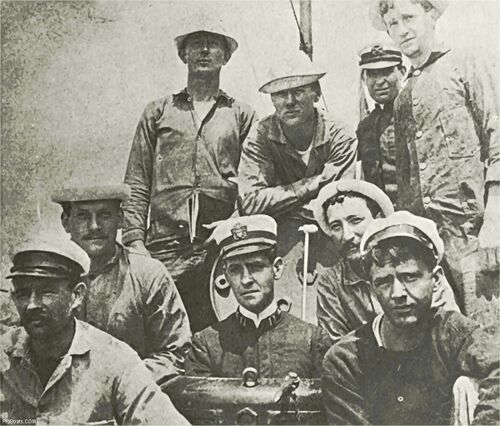
This is the crew of USS Holland, and the first U.S. Navy crew assigned to a submarine. These were brave men operating a futuristic machine on a new frontier. They were pathfinders in the truest sense of that word.
In the center of the picture is Lieutenant Harry H. Caldwell, Commanding Officer (who bears a striking resemblance to actor Gabriel Byrne). Starting at the lower left of the picture and going clockwise are:
•William H. Reader, Chief Gunner's Mate
•Augustus Gumpert, Gunner's Mate
•Harry Wahab, Gunner's Mate 1st Class
•O. Swanson, Gunner's Mate 1st Class
•Owen Hill, Gunner (Warrant Officer)
•Walter A. Hall, Electrician's Mate 2nd Class
•Arthur Callahan, Gunner's Mate 2nd Class
•Barnett Bowie, Chief Machinist's Mate
U.S. Navy photo.
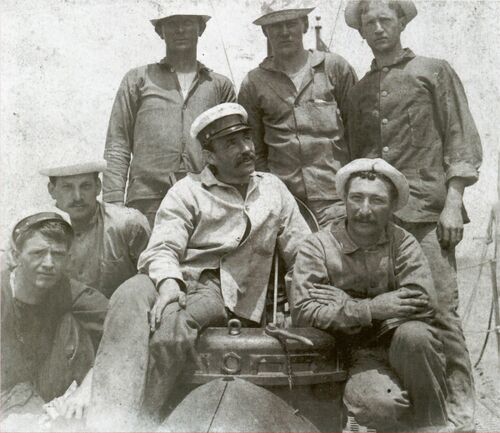
In the U.S. Navy Submarine Service, the Chief of the Boat (COB) is an experienced and wise Chief Petty Officer and the senior enlisted man aboard. He is the principal enlisted advisor to the commanding officer, and is the CO's "get it done man". Not only is he a subject matter expert on all things submarine, but he also keeps the enlisted men moving forward, sometimes with sharp and pointed words, sometimes with a grandfatherly pat on the back and wise insight. This photo highlights the force's very first COB, Chief Gunner's Mate William H. Reader, USN (center). Arrayed around him are the remainder of the Holland's first enlisted crew, the same men in the photo above.
U.S. Navy photo.
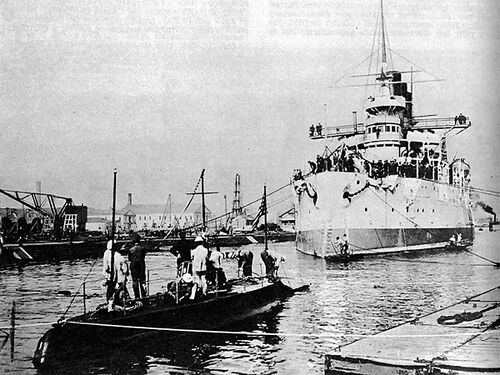
The Holland entering dry dock at the Brooklyn Navy Yard in New York City, October, 1901. She is sharing the dry dock with the Russian battleship Retvizan. The Russian battleship was undergoing a refit prior to heading to join the Russian Pacific fleet at Port Arthur (present day Lushunkou, China). Retvizan had been built for the Imperial Russian Navy by the United States. Retvizan was torpedoed and heavily damaged prior to the famous Battle of Tsushima Straight in the Russo-Japanese War. But she was repaired in time to participate in the battle. She survived and was eventually taken over by the Japanese and renamed Hizen. She served Japan until being sunk as a gunnery target in 1924.
U.S. Navy photo.
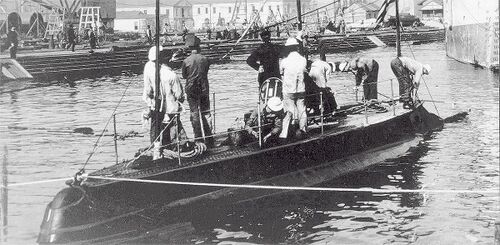
A high resolution closeup of Holland from the above photo. The bow is facing the camera. Her crew is all topside, working to ensure the lines are ready to steady the boat when the dock pumping begins.
U.S. Navy photo.
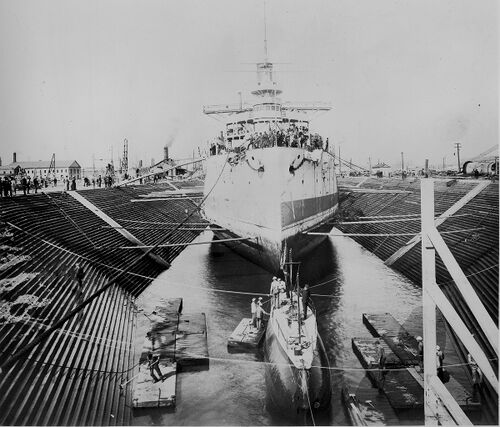
Another view of Holland and Retvizan during the 1901 Brooklyn Navy Yard drydocking. In this photo the water is nearly drained and both ships are sitting firmly on the keel blocks at the bottom of the dock. LT Caldwell can be seen on Holland's deck, carefully monitoring the draining of the water.
U.S. Navy photo.
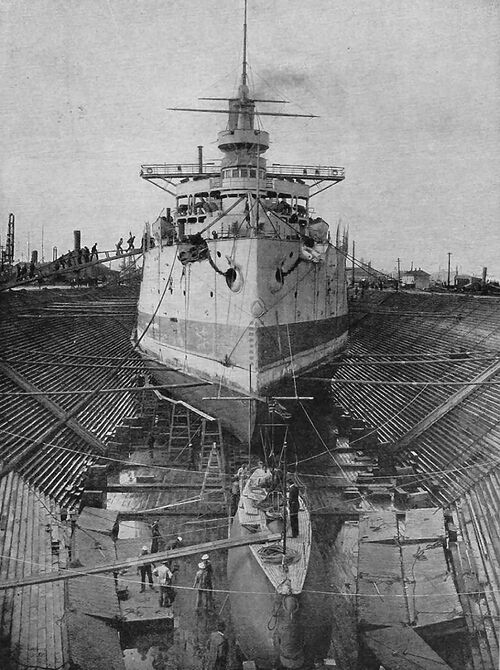
This photo was taken several minutes after the one above, and shows the dock drained. An access gangplank has been placed to provide a means of getting to the Holland. Time would not be wasted and the men would get to work immediately.
U.S. Navy photo.
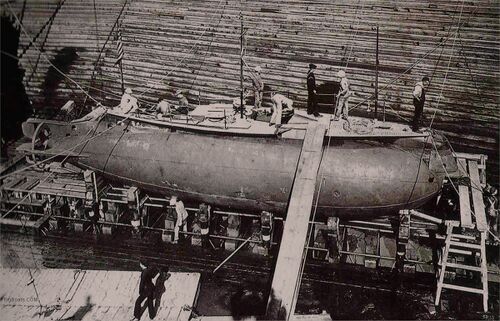
Another view of Holland during the 1901 drydocking. This shot gives a good view of her hull shape, a beautifully tapered cylinder. The Navy would quickly diverge from this hydrodynamically optimal shape, but would return to it in the 1960's and the Skipjack-class nuclear submarines with their "Albacore" style hulls.
U.S. Navy photo.
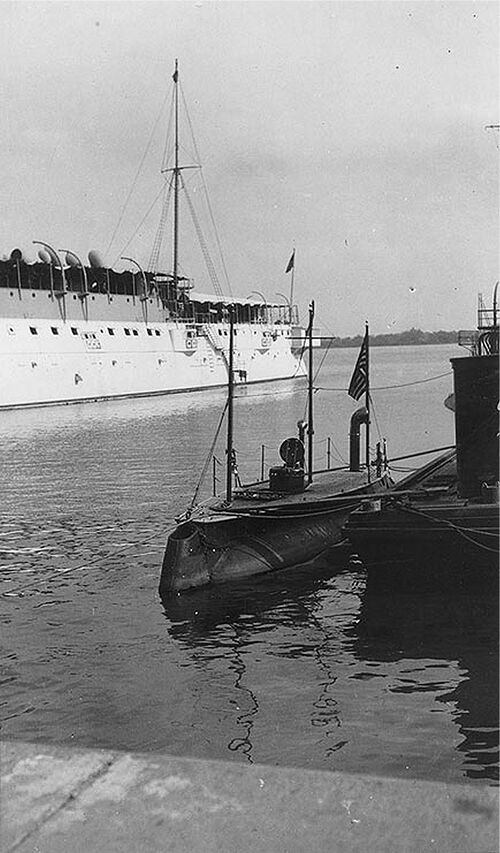
The diminutive Holland moored at the Philadelphia Navy Yard in 1901. USS Columbia (Cruiser No. 12) is partially visible in the background. The muzzle door for Holland's pneumatic gun is open. Theoretically, the gun was capable of launching it's dynamite shells while the boat was submerged, making the Holland the first submarine capable of launching a ballistic missile while submerged! While there is only anecdotal evidence to show that she actually did launch a projectile while submerged, she was certainly capable of doing so.
U.S. Navy photo.
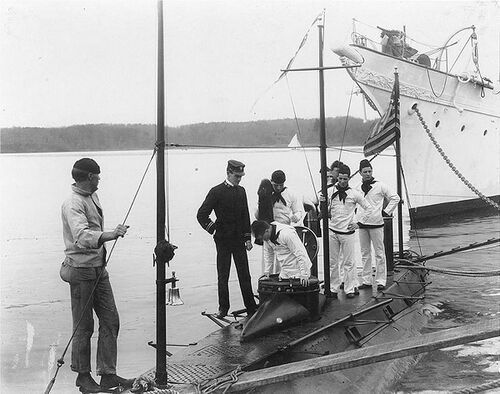
At the U.S. Naval Academy, Annapolis, Maryland, circa 1901-1902, with several midshipmen on board. Among the midshipmen are, as identified from names on their uniforms:
•Naval Cadet Henry G.S. Wallace (entering conning tower)
•Naval Cadet John W. Woodruff (behind Wallace)
•Naval Cadet John. H. Blackburn (by the mast) and
•Naval Cadet William J. Moses (in front of the flag).
The careful method that Wallace is using to go down the hatch emphasizes the boat's small size and the fact that you did not enter the Holland, you put it on.
The officer standing by the conning tower is probably Holland's Commanding Officer, Lieutenant Harry H. Caldwell. Note Holland's bell mounted on her foremast, commissioning pennant flying from the top of her mainmast, outriggers fixed along her deck edge for decking that has been removed and the bow of the converted yacht USS Gloucester in the right background.
U.S. Navy photo.
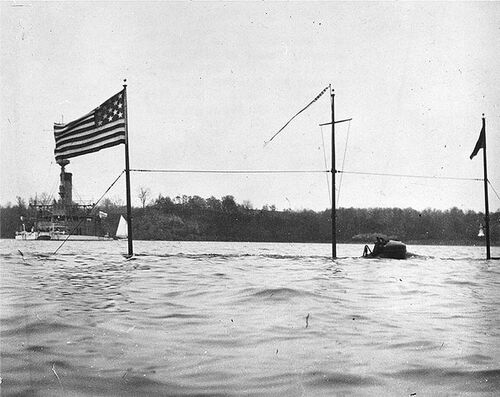
Holland partially submerged in the Severn River off the U.S. Naval Academy, Annapolis, Maryland, in the summer of 1901. Maybe with cadets aboard as riders. Note the submarine's 13-star "boat" flag, signal mast fitted amidships and commissioning pennant. A large coastal monitor, possibly an Amphitrite-class vessel, is in the left background.
U.S. Navy photo.
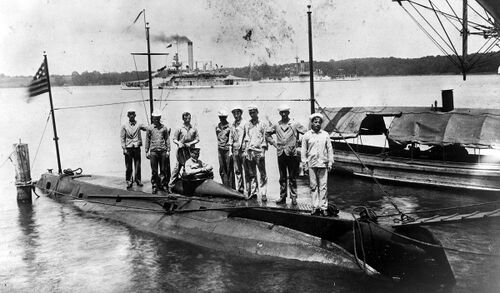
Holland and her crew posing for a portrait while stationed at the Naval Academy circa 1903-1904. Two coastal defense monitors are anchored in the background, a steam launch is moored alongside as a comparison for size. The left hand monitor is an Arkansas-class vessel, and the other is of the Amphitrite-class.
U.S. Navy photo.
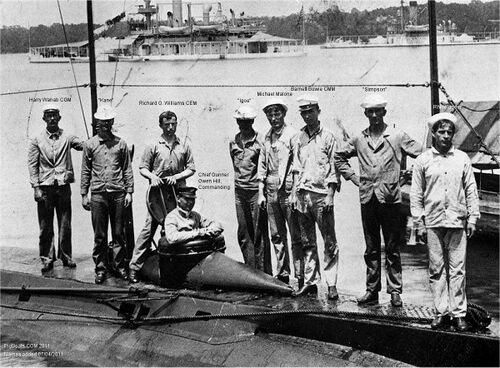
A closeup of the photo above, with callouts for the crew's names. By this time Gunner Owen Hill had taken over as Commanding Officer, a very rare occasion in which a warrant officer commanded a commissioned warship.
U.S. Navy photo.

Harry Wahab and Richard O. Williams, two of Holland's crewmen, seen here on April 11, 1947 at the Naval Academy at Annapolis. They stand by a model of the Holland, the Navy's first submarine, which had been accepted for service 47 years previously.
U.S. Navy photo.
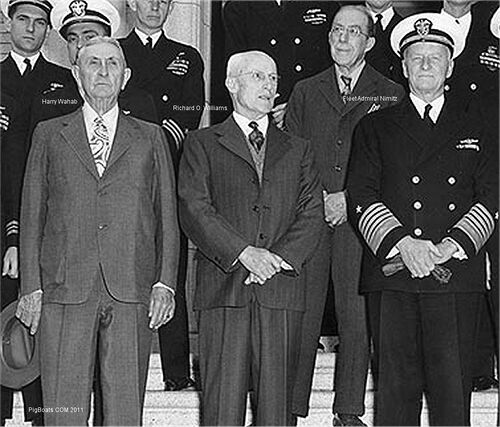
Wahab and Williams in the company of a distinguished guest, Fleet Admiral Chester W. Nimitz at the Naval Academy, April 11, 1947. At the time of the photo Nimitz was the Chief of Naval Operations at the Pentagon. Nimitz was also a submariner, and commanded one of the Holland's follow-on boats, the USS Plunger (Submarine No. 2) in 1909.
U.S. Navy photo.
The Twilight of a Career

Photo courtesy of NARA.

The ex-USS Holland hauled out at the Norfolk Navy Yard, Portsmouth, VA. The Holland had been struck from the Navy List on November 21, 1910, but her hulk lingered at the yard for several years. The men in the photo are in dress whites making this photo taken after Memorial Day, probably in 1911 since there isn't much taken from the Holland, just a few panels. The fairing in the bow and the fairing that surrounded the conning tower is gone as well.
The ship on the right in the photo is a Delaware-class battleship, either the Delaware (BB-28) or the North Dakota (BB-29). The ship in the background is a Virginia-class battleship, either the Georgia (BB-15) or the New Jersey (BB-16). The crew on the dock could be from any ship in the area.
Thanks to Charles Haberlein for identification.
Photo in the private collection of Ric Hedman.
-
Photo in the private collection of Ric Hedman.
-
New-York Tribune/Library of Congress image.
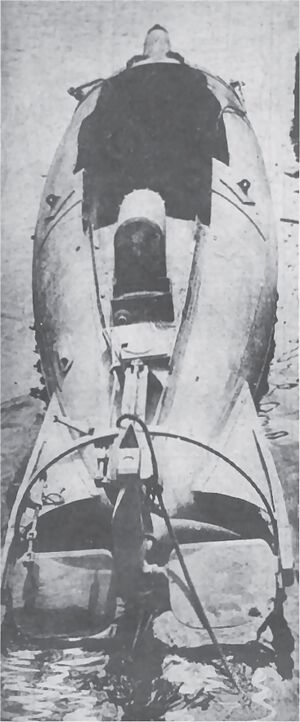
Stripped out hulk of the ex-Holland awaiting the end. The remnants of the after Zalinsky gun housing can be seen. The gun was removed before final Navy acceptance trials.
Evening Public Ledger.(Philadelphia)/Library of Congress image.
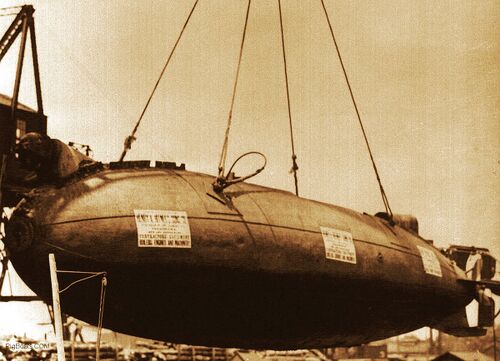
ex-Holland being lifted to a rail car for transport, June 1915. The attached signs are apparently for the scrap company that now owned her.
Image Contributed by Gary McCue.
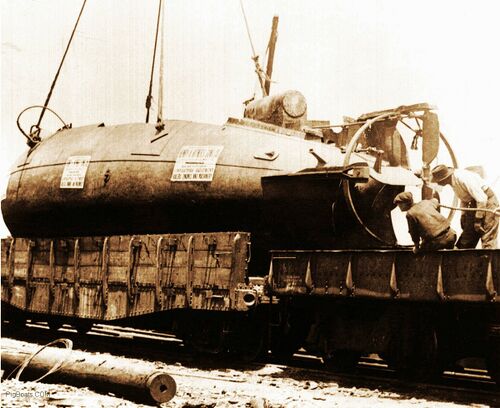
ex-Holland now on the blocks for transport by rail car, June 1915. Workmen are inspecting the positioning of the boat to ensure it is properly placed for transport.
Image Contributed by Gary McCue.
-
Photo in the private collection of Ric Hedman.
-
Iron County Record (Cedar City, Utah)/Library of Congress image.
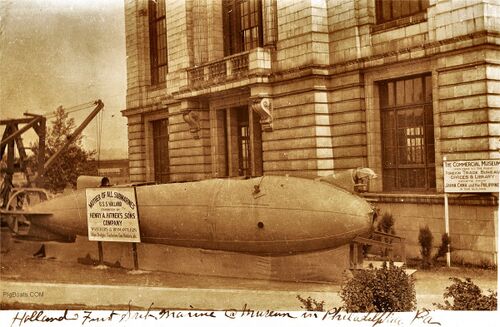
This photo shows the ex-Holland on display outside of the Commercial Museum in Philadelphia, approximately 1915. Her hulk is owned by the Henry A. Hitner & Sons Company, a scrap firm. Realizing the commercial value of the old boat, they put it on display trying to earn some money off of it.
There is a platform built at the front of the submarine so visitors can look inside the sub through the torpedo tube opening. The tube and outer door had been removed by the Navy at decommissioning.
This photo is distorting the actual shape of the boat, making it appear to be longer and thinner than it actually was. It is probably an artifact of the photography process.
Image Contributed by Gary McCue.
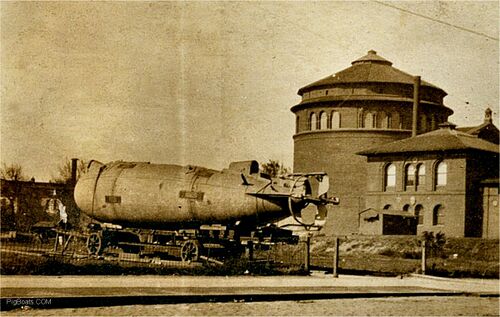
The ex-Holland in Philadelphia at what is today the University of Pennsylvania Museum across the street from Franklin Field. The submarine is sitting on what will become part of museum building. It appears from this photo that South Street was at one time closer to the museum building than it is today.
Compare images above with this one and you will see iron "straps" riveted to the hull fore and aft where the hull has been cut apart for transportation and then rejoined. In all the images to follow you will see these straps.
Image Contributed by Gary McCue.
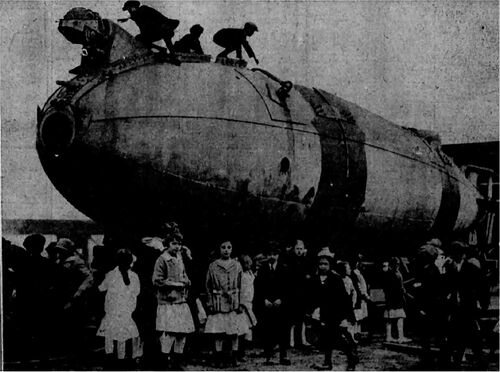
In August of 1916 she was privately purchased from Hitner by a Dr. Peter J. Gibbons and his son for $350.00 to be used for display and possibly placed in a museum. Here in this October 17, 1916 photo and newspaper story, "OLD SUBMARINE PROVES A HARMLESS TOY FOR SCHOOL CHILDREN" "Children of the McCall School paid a visit to the submarine Holland (SS-01), the first sub-sea craft in the United States Navy. The Holland is reposing, like a stranded amphibian, in the empty lots opposite Franklin Field before it goes to the Irish bazaar, in New York."
Evening Public Ledger.(Philadelphia)/Library of Congress image.
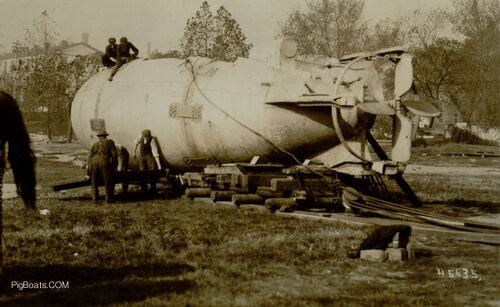
The ex-Holland is being prepared for transport to be in the Columbus Day Parade in Philadelphia, so the date has to be just prior to October 12, 1916.
The two cuts made in the hull to transport it to this location are clearly seen. The straps that riveted the hull sections back together are also clearly visible. The submarine appears to have been cut to move her from the Philadelphia Commercial Museum to the University of Pennsylvania Museum. Workmen are placing roller logs under the cradle and a large block and tackle have been rigged to the hull.
Photo in the private collection of Ric Hedman.
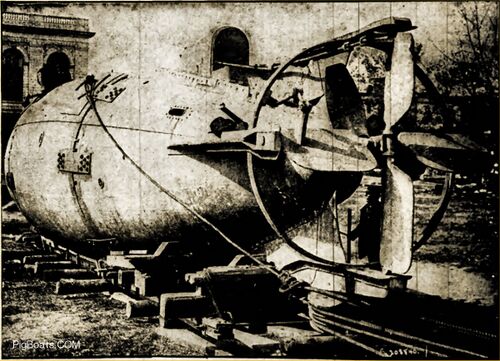
A photo from the Boston Courier newspaper taken some time shortly after the photo above was taken shows the logs in place and the slack taken up in the block and tackle ready to move the submarine. Part of the University of Pennsylvania Museum can be seen in the background.
Photo from the Buffalo Courier, October 29, 1916.
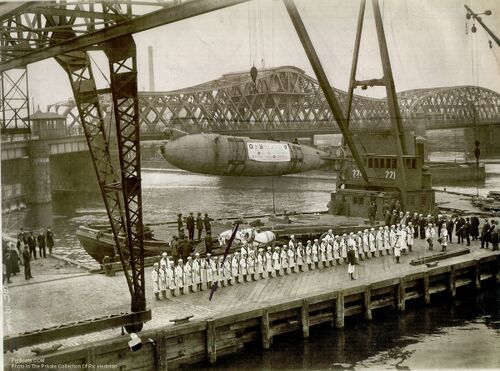
May 25, 1917 the ex-Holland is lifted from a barge on its way to the Bronx International Exposition. The bridge in the background is the Willis Avenue Bridge from Manhattan to the Bronx and is still there looking almost the same. The Bronx is to the right in this photo. The pier is located at 125th Street and the Harlem River. The group in uniform is a contingent of the Junior Naval Reserve and is there as an honor guard.
The sign reads: "Old Holland #9; Daddy Of All Submarines; (unreadable words); Bronx International Exposition Grounds; 177st Subway Station & Bronx River". Again, the misunderstanding about what build number the ex-Holland was. The ex-Holland was hull #6 not #9 in John Holland's design scheme and was the one the Navy bought. The Holland was to remain at this spot, as a derelict hulk until 1932 when she was purchased by the Harlem Metal Corporation for $100 and cut up for scrap. It was a sad end for such a historic vessel, and a complete shame that she was not preserved as a museum.
Photo in the private collection of Ric Hedman.
Page created by:
Ric Hedman & David Johnston
1999 - 2023 - PigBoats.COM©
Mountlake Terrace, WA, Norfolk, VA
webmaster at pigboats dot com

